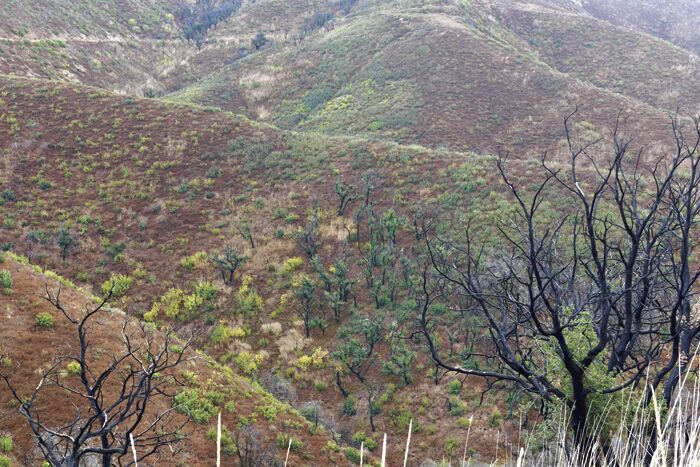
to the Santa Monica Mountains. It was the worst fire ever recorded there; 150 square miles burned, including roughly 88 percent of the Santa Monica Mountains National Recreation Area (SMMNRA). Two of the 13 National Park Service (NPS) collared mountain lions perished. The burned areas were an ashy gray and black moonscape devoid of any visible life immediately following Woolsey, as far as the eye could see. Many residents, seeing this, despaired about whether nature would ever return.
Three years later, life is returning, through a mixture of natural recovery and native plant restoration by humans.
Mark Mendelsohn, the biologist heading the NPS long-term vegetation monitoring program on 300 plots of land, explained in a phone interview that the vegetation has made a very good recovery so far because of the amount of rain that fell in 2019 and 2020—among those doing the best are annual plants and native shrubs, sage and chaparral.
He said even though 2021 has been extremely dry, and a poor year for grasses and wildflowers, “The chaparral areas still looked quite green, and we hope the previous rains really jump-started their recovery, and that they’ll be OK.”
The biologist said the upcoming rainy season would be “critical” for plants continued recovery, noting that even though the National Oceanic and Atmospheric Administration (NOAA) recently predicted another dry La Niña year, predictions from a different agency say there may actually be above average rainfall and a lower than normal number of Santa Ana wind events coming.
The riparian areas near creeks are a “mixed bag” in terms of their recovery, Mendelsohn observed. It will take decades for the seedlings of large trees like sycamores and oaks to reach full size again, yet many of the existing oak trees survived the fire and have resprouted.
“They’re not very easily killed off by a single drought year and are doing fairly well,” he reported.
NPS restoration biologist Joey Algiers is leading volunteer efforts to “rewild” the Santa Monica Mountains, focusing on burn areas. The nonprofit Re:wild, together with the National Park Service and Snap, Inc., teamed up to plant 100,000 native trees, grasses, plants and shrubs, including coastal sagebrush species and giant wild rye, between 2021 and 2023.
NPS will monitor the newly planted vegetation over the next three years, and also monitor sensitive habitats to make sure invasive species aren’t spreading—an aftereffect of wildfire.
All the thousands of new native plantings have to come from somewhere, and the growing of replacement plants was ramped up significantly for restoration of the extensive burn areas.
“Plants used in initial restoration have to grow fast and adapt quickly and be important for birds, pollinators and erosion control,” said Antonio Sanchez, native plant nursery manager. “There’s now a big push to grow more native Coast Live oaks, Valley oaks and Scrub oaks, because they’re relatively fire resistant and important to the ecosystem. Paramount Ranch, Cheeseboro Canyon and Rancho Sierra Vista are the areas the nursery is most focused on replanting right now—the ‘big three.’ … Paramount [Ranch] could take as many as a million plants.”
Rosi Dagit, a senior biologist at the Resource Conservation District of the Santa Monica Mountains, noted that “One of the most unusual impacts of Woolsey was the severe loss of riparian vegetation.
“Typically, riparian corridors burn less intensely, but perhaps due to the previous seven-year drought, and the impacts of invasive beetles, they were more susceptible this time and entire creek corridors lost all their canopy cover,” Dagit continued, later adding, “The loss of critical vernal pool habitat for Western pond turtles and endangered red-legged frogs was dire.” Both species were still hanging on, with help.
Scientists were still coming across examples of animals adapting to the post-fire environment. Last April, three bobcat kittens and their mother were documented living in the cavity of a large oak tree in an area that was intensely burned in the Woolsey Fire. An NPS scientist said at the time it was very unusual for a bobcat to den in a tree, but the mother must have chosen that location because so much of the natural habitat in the area was destroyed.
There are currently 13 mountain lions being tracked with radio collars—pretty much the same number as before the fire.
Mendelsohn said there are no specific scientific studies being done on the comeback of smaller mammals and birds, although he observed that wood rats were having a difficult time re-establishing themselves after their woody nests burned.
